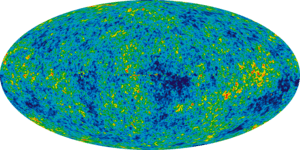Ehlers–Geren–Sachs theorem
The Ehlers–Geren–Sachs theorem, published in 1968 by Jürgen Ehlers, P. Geren and Rainer K. Sachs, shows that if, in a given universe, all freely falling observers measure the cosmic background radiation to have exactly the same properties in all directions (that is, they measure the background radiation to be isotropic), then that universe is an isotropic and homogeneous FLRW spacetime.
Using the fact that, as measured from Earth, the cosmic microwave background is indeed highly isotropic—the temperature characterizing this thermal radiation varies only by tenth of thousandth of a kelvin with the direction of observations—and making the Copernican assumption that Earth does not occupy a privileged cosmic position, this constitutes the strongest available evidence for our own universe's homogeneity and isotropy, and hence for the foundation of current standard cosmological models. Strictly speaking, this conclusion has a potential flaw. While the Ehlers–Geren–Sachs theorem concerns only exactly isotropic measurements, it is known that the background radiation does have minute irregularities. This was addressed by a generalization published in 1995 by W. R. Stoeger, Roy Maartens and George Ellis, which shows that an analogous result holds for observers who measure a nearly isotropic background radiation, and can justly infer to live in a nearly FLRW universe.[1]
References
- ↑ See pp. 351ff. in Hawking, Stephen W.; Ellis, George F. R. (1973), The large scale structure of space-time, Cambridge University Press, ISBN 0-521-09906-4. The original work is Ehlers, J., Geren, P., Sachs, R.K.: Isotropic solutions of Einstein-Liouville equations. J. Math. Phys. 9, 1344 (1968). For the generalization, see Stoeger, W. R.; Maartens, R; Ellis, George (2007), "Proving Almost-Homogeneity of the Universe: An Almost Ehlers-Geren-Sachs Theorem", Ap. J., 39: 1–5, Bibcode:1995ApJ...443....1S, doi:10.1086/175496.
